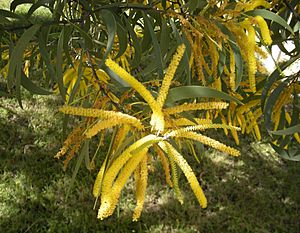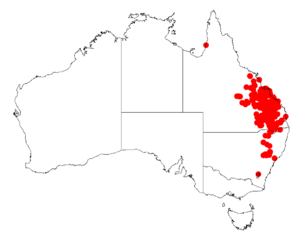Acacia crassa facts for kids
Quick facts for kids Curracabah |
|
|---|---|
 |
|
| Scientific classification | |
| Genus: |
Acacia
|
| Species: |
crassa
|
 |
|
| Occurrence data from AVH | |
Acacia crassa, also known as the curracabah, is a type of wattle tree or shrub. It grows naturally in eastern Australia.
What is Curracabah?
This plant can grow quite tall, up to 12 metres (39 ft) (about 39 feet). It has bark that looks a bit wrinkly and cracks near the bottom. Its branches are strong and can be light grey, dark grey, or reddish-brown. They often have small, raised spots called lenticels.
The leaves of the curracabah are special. They are not true leaves but flattened leaf stems called phyllodes. These are usually 12 to 24 centimetres (5 to 9 in) (about 5 to 9 inches) long. They are narrow and taper at both ends. Each phyllode has three main veins that stand out.
Flowers and Seeds
The curracabah flowers between July and October. The flowers appear later in the year the further south the plant is. It produces flower-spikes that are 4 to 8 cm (1.6 to 3.1 in) (about 1.5 to 3 inches) long. These spikes are packed with bright golden flowers.
After the flowers bloom, the plant grows smooth, straight seed pods. These pods are raised over the seeds and squeezed between them. They are about 4.5 to 10 cm (1.8 to 3.9 in) (about 2 to 4 inches) long. Inside the pods are black, oval-shaped seeds. Each seed is about 3 to 6 mm (0.118 to 0.236 in) (about 0.1 to 0.2 inches) long.
Where Does it Grow?
The curracabah grows along the Great Dividing Range. This area stretches from Mackay in Queensland down to Newcastle in New South Wales. You can find it in areas with sandstone and rocky ground. It prefers gravelly, sandy, or clayey soils.
This plant usually grows in certain types of plant communities. These include sclerophyll woodlands, which have tough-leaved plants. It also grows in heathlands or open scrub areas.
How Was it Named?
The curracabah was first officially described by a botanist named Leslie Pedley. This happened in 1974. He wrote about it in a scientific paper called Contributions from the Queensland Herbarium.
Later, in 1987, Pedley reclassified it. He moved it to a different group called Racosperma crassum. But then, in 2001, it was moved back to the Acacia group.
Subspecies
There are two known types of Acacia crassa, called subspecies:
- Acacia crassa subsp. crassa
- Acacia crassa subsp. longicoma
The curracabah is part of a group of wattles called the Acacia cunninghamii group. It is closely related to other wattles like Acacia concurrens, Acacia leiocalyx, Acacia longispicata, and Acacia tingoorensis.

